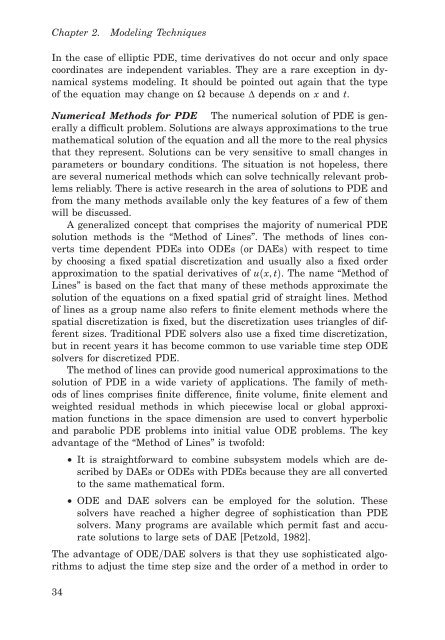Design and Implementation of Object-Oriented ... - Automatic Control
Design and Implementation of Object-Oriented ... - Automatic Control
Design and Implementation of Object-Oriented ... - Automatic Control
You also want an ePaper? Increase the reach of your titles
YUMPU automatically turns print PDFs into web optimized ePapers that Google loves.
Chapter 2. Modeling Techniques<br />
In the case <strong>of</strong> elliptic PDE, time derivatives do not occur <strong>and</strong> only space<br />
coordinates are independent variables. They are a rare exception in dynamical<br />
systems modeling. It should be pointed out again that the type<br />
<strong>of</strong> the equation may change on Ω because Δ depends on x <strong>and</strong> t.<br />
Numerical Methods for PDE The numerical solution <strong>of</strong> PDE is generally<br />
a difficult problem. Solutions are always approximations to the true<br />
mathematical solution <strong>of</strong> the equation <strong>and</strong> all the more to the real physics<br />
that they represent. Solutions can be very sensitive to small changes in<br />
parameters or boundary conditions. The situation is not hopeless, there<br />
are several numerical methods which can solve technically relevant problems<br />
reliably. There is active research in the area <strong>of</strong> solutions to PDE <strong>and</strong><br />
from the many methods available only the key features <strong>of</strong> a few <strong>of</strong> them<br />
will be discussed.<br />
A generalized concept that comprises the majority <strong>of</strong> numerical PDE<br />
solution methods is the “Method <strong>of</strong> Lines”. The methods <strong>of</strong> lines converts<br />
time dependent PDEs into ODEs (or DAEs) with respect to time<br />
by choosing a fixed spatial discretization <strong>and</strong> usually also a fixed order<br />
approximation to the spatial derivatives <strong>of</strong> u(x, t). The name “Method <strong>of</strong><br />
Lines” is based on the fact that many <strong>of</strong> these methods approximate the<br />
solution <strong>of</strong> the equations on a fixed spatial grid <strong>of</strong> straight lines. Method<br />
<strong>of</strong> lines as a group name also refers to finite element methods where the<br />
spatial discretization is fixed, but the discretization uses triangles <strong>of</strong> different<br />
sizes. Traditional PDE solvers also use a fixed time discretization,<br />
but in recent years it has become common to use variable time step ODE<br />
solvers for discretized PDE.<br />
The method <strong>of</strong> lines can provide good numerical approximations to the<br />
solution <strong>of</strong> PDE in a wide variety <strong>of</strong> applications. The family <strong>of</strong> methods<br />
<strong>of</strong> lines comprises finite difference, finite volume, finite element <strong>and</strong><br />
weighted residual methods in which piecewise local or global approximation<br />
functions in the space dimension are used to convert hyperbolic<br />
<strong>and</strong> parabolic PDE problems into initial value ODE problems. The key<br />
advantage <strong>of</strong> the “Method <strong>of</strong> Lines” is tw<strong>of</strong>old:<br />
• It is straightforward to combine subsystem models which are described<br />
by DAEs or ODEs with PDEs because they are all converted<br />
to the same mathematical form.<br />
• ODE <strong>and</strong> DAE solvers can be employed for the solution. These<br />
solvers have reached a higher degree <strong>of</strong> sophistication than PDE<br />
solvers. Many programs are available which permit fast <strong>and</strong> accurate<br />
solutions to large sets <strong>of</strong> DAE [Petzold, 1982].<br />
The advantage <strong>of</strong> ODE/DAE solvers is that they use sophisticated algorithms<br />
to adjust the time step size <strong>and</strong> the order <strong>of</strong> a method in order to<br />
34














